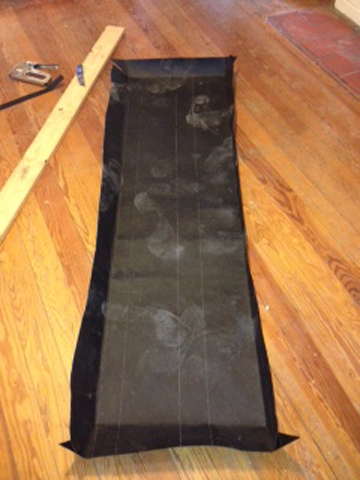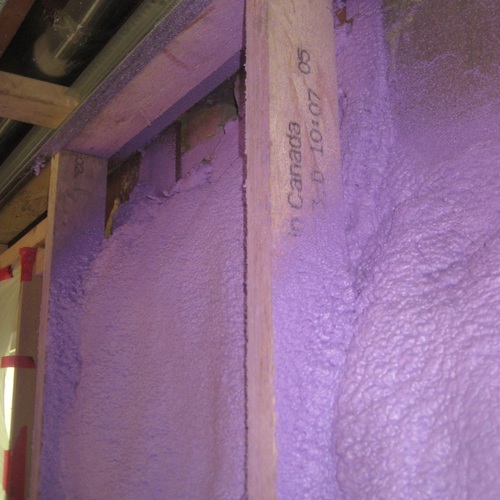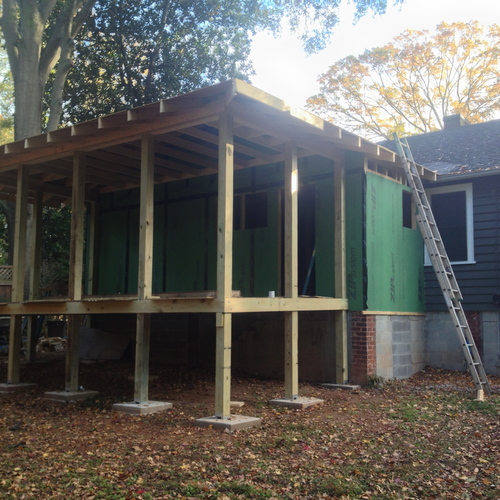Image Credit: Carl Seville
Image Credit: Carl Seville The strips of asphalt felt were installed in each stud cavity to prevent the spray foam from contacting the back of the siding. These strips of felt create an "interior rainscreen." Spray foam insulation was installed in the wall cavities over the strips of asphalt felt. Keeping the spray foam from direct contact with the back side of the siding will help limit moisture damage and extend the durability of the wall structure.
Over the past dozen or so years my opinion on spray foam insulation has evolved from being a strong advocate to being slightly skeptical.
I have come to the conclusion that any well-designed new building can be insulated with any properly installed insulation. When it comes to renovations, however, spray foam often has some distinct advantages.
About eight years ago, I installed spray foam on the roofline and floor of my house, which, I now realize, was not a particularly good decision. Since I had no HVAC ducts in the attic, I probably should have insulated and air sealed the ceiling, and sealing and insulating the crawlspace would have been a better choice as well.
But that is all water under the bridge. I would have preferred to use something else in my current renovation, but since the floor and roofline were already insulated with spray foam, it didn’t make sense to switch products (and relocate the thermal enclosure location in the process).
What should I do with the walls?
Ready for insulation, I hired an experienced Icynene installer to insulate the new walls, roofline, and floor areas, as well as to touch up some thin areas from the earlier install.
I chose not to install any insulation on most of the existing exterior walls as they were not being stripped. The existing wood lap siding is in excellent condition, and with no sheathing or weather barrier, I was concerned that installing insulation would lead to moisture retention in the wall cavity and possible damage to the structure and siding. Since the climate in North Georgia (Zone 3A) is relatively mild, I decided that the added value from wall insulation would not be worth the risk of moisture damage, and removing either the siding or the plaster to allow the walls to be insulated was not in the budget.
At the one small section of wall where the interior was exposed, I installed felt on the inside of the wall to keep the insulation away from the siding, providing a sort of makeshift rainscreen between the siding and the insulation. I can’t say for sure how well this will work, but there is enough of a roof overhang that any moisture that gets in the wall cavity should be able to dry out, keeping the wall safe from damage.
Rolling towards completion
Insulation and drywall are installed, interior finishes are moving along smoothly, and the house should be ready to re-occupy close to the end of the year. The outside work is progressing, although some bad weather and the Thanksgiving holiday slowed progress a bit.
I’m looking forward to seeing how well the Home Slicker rainscreen works with the siding – a combination of reused and new material. And I am particularly interested in seeing the Perennial wood porch flooring and rails installed.
Weekly Newsletter
Get building science and energy efficiency advice, plus special offers, in your inbox.
















3 Comments
I would not need to worry
I would not need to worry about weather barrier in new construction would I? There is foam insulation in wall and then the alarm guy drilled into the windows where he shouldn't have. There is also a feature missing above the window at the exterior that helps to keep water away. (Is eave the word?)
Also, we were hoping to run electric and plumbing in this wall because we could tie into a washer dryer connection down on the first floor. Would it be better to tie into the bathroom on a non insulated wall? Either way we will need to vent the dryer. Thanks for your help!
Response to Heidi Hicks
Heidi,
Every wall needs a water-resistive barrier (WRB). Whether or not you need to worry about it depends on the knowledge and skill of your contractor. If you want to know what material was used as your WRB, ask your contractor.
The eave is the edge of your roof that the water drips off. The word you are looking for -- the metal piece or membrane above a window that helps keep water out of your wall -- is "flashing."
If you want to know the best route for electrical wiring in your house, ask an electrician. You haven't provided us enough information to answer your question.
You are right. I failed to
You are right. I failed to mention this would be to add a washer dryer connection in a corner where a foam insulated exterior wall meets the other side of an interior bathroom wall. (Those are the two options for tying into plumbing but I would prefer the opposite corner for design purposes which would mean going through the foam wall. I am trying to decide how much foam will complicate a remodel and my option period will be over before I can get an electrician out there. I was not aware of the issue because there are no examples I can find online of anyone remodeling a remodel. Which was brought to my attention in a few isolated comments I came across related to foam insulation in general. Is it really that big of a deal to remove enough open cell foam insulation to plumb and do electric if that turns out to be the best route for the washer dryer connection. Thanks so much for your help!
Log in or create an account to post a comment.
Sign up Log in